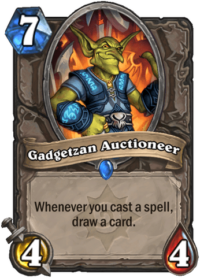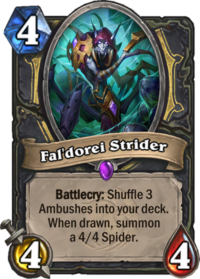One of the most memorable archetypes in Hearthstone history, Miracle Rogue has been a stable of the game across the years. Still, the „miracle” in question has always been a little different – though it always involved drawing a crapton of cards on the cheap, a deeper examination of the archetype’s evolution tells us a lot about how the game has changed over the years.
Primordial Miracles
The original miracle was a load of damage to your face. As you can experience again in Classic Mode, a combination of the 4-mana Leeroy Jenkins, double Shadowstep and a bunch of additional burn (Eviscerate, Cold Blood and maybe a Preparation and a Sap thrown in for good measure) added up to 26 damage from hand on ten mana, which was – and is – almost always enough to finish off the match.
- 0Backstab2

- 0Preparation2

- 0Shadowstep2

- 1Cold Blood2

- 1Conceal2

- 1Deadly Poison2

- 2Blade Flurry1

- 2Eviscerate2

- 2Sap1

- 2Shiv2

- 3Edwin VanCleef1

- 3Fan of Knives2

- 3SI:7 Agent2

This massive payoff meant that the entire deck was geared towards drawing the cards required for this and little else, and the 5-mana version of Gadgetzan Auctioneer coupled with Conceal was one of the strongest draw engines in the game, if somewhat susceptible to face pressure. In the hands of experienced players, it served as one of the best decks in the Classic format and the core combination of zero-mana spells serving as fuel for some sort of payoff remained a stable of Miracle Rogue decks ever since.
Best Deals Everywhere

Gadgetzan Auctioneer remained a key part of the Miracle Rogue experience even after its nerf at the end of 2014 that bumped up its cost to six mana with the arrival of the Goblins versus Gnomes set. Still, the archetype continued to receive support, most notably in the form of Oil Rogue (named after Tinker's Sharpsword Oil at the time, which opted for the Preparation + Sprint combo to draw into its devastating damage output. Instead of Leeroy Jenkins (freshly nerfed to five mana), the massively buffed weapons coupled with the old Blade Flurry (which still went face) served as the way to close out the game.
Though Rogue players had a hard time in and around the TGT era, their favorite archetype received a key supporting piece from League of Explorers in the form of Tomb Pillager. Though the field was quite hostile due to Aggro Shaman’s Tunnel Trogg-fueled shenanigans and Secret Paladin being none of your business, there were signs of life for the archetype with this help to the old draw engine.
The relative drop in power level brought along by the introduction of the Standard format meant that the deck finally returned to relevance in the Whispers meta, and the nerf-slash-destruction of Blade Flurry meant that the popular builds began packing Questing Adventurers alongside the usual suspects to dominate the board, with the occasional Conceal thrown in for good measure. In a way, this marked the beginning of a sea change in Miracle Rogue strategies where the payoff was less about instant burn damage and more about tempo gain instead.
This was further reinforced by the card releases in the upcoming sets. Small redraw tools like Swashburglar, explicit support in the form of Counterfeit Coin and one of the most brutal tempo options in the form of Vilespine Slayer (not to mention the omnipresent Patches the Pirate) offered an interesting amalgamation of options for Miracle Rogue fans, even if the deck was eventually pushed aside by the even more brutal Quest Rogue variants and Keleseth Rogue.
Soon thereafter, Conceal was moved to the Hall of Fame at the end of the Year of the Kraken. The devs provided this commentary at the time:
“Stealth is a very powerful mechanic, and can also be very frustrating to play against—more for some classes than others. Hearthstone should ultimately be a game of plays and counter plays, and Conceal makes it increasingly more difficult for other classes to interact with Rogue minions as time goes on. We considered promoting Gadgetzan Auctioneer to Wild instead, but in the end we decided to move Conceal because Auctioneer has proven to be one of the most skill testing cards in the game. We think the power level of Auctioneer decreases with this change, and games where Auctioneer is played will be a bit more interactive.”
Different Deals

The next big evolution was brought along by Fal'dorei Strider in Kobolds and Catacombs, further fueling the tempo-oriented payoffs of Miracle Rogue builds. Again, the resurgence was short-lived due to the emergence of a superior archetype in the form of Odd Rogue early on in the following Hearthstone year, which directly led to the nerf of Cold Blood in February 2019, taking away yet another tool from the original deck’s kit.
Though tempo-heavy Rogue decks relying on Shadowstep shenanigans flickered in and out of the meta ever since, it’d be a stretch to call any of them a good old-fashioned “Miracle” build. Drawing most of your deck in order to assemble a big payoff is a normal facet of gameplay for most combo decks: being able to do so ridiculously quickly because so much of your deck costs 0 and 1 mana is unique to Rogue. Now that Edwin VanCleef is also gone, the archetype is once again experiencing a sea change, with a partial shift from the pure tempo payoff towards resource generation.
From miracle to bullshit, you could say, if you were so inclined.
A quick look at Orange’s recent #3 Legend build gives a good idea of what this change entails. Apart from Wicked Stab (Rank 1) (the distant cousin of Eviscerate) and Alexstrasza the Life-Binder at a bullshit-prohibitive 9 mana, there’s basically no burn to speak of in the deck. The flexibility and the insane redraw potential is only partially used for tempo plays, too: though Prize Plunderer is a heck of a removal tool, most of the cards here involve resource generation and keeping your hand full at all times more reminiscent of the Secret Rogue builds of yesteryear than the past Miracle decks.
There’s also a smidgen of burgling in there with Wand Thief and Vanessa VanCleef, Team 5 finally finding a way to inject the thievery flavor into a competitive Rogue deck. It certainly has enough in common with the archetype to earn the Miracle moniker, making seemingly impossible plays with little mana to spar over and over again.
Though the ebb and flow of a Core set instead of an omnipresent evergreen Classic one will inevitably enable more ways for the devs to adjust the direction various archetypes are headed in, it seems quite clear that this new breed of Miracle Rogue will be the one to stay for the foreseeable future. It just goes to show that an abstract concept like this can come in many forms, providing payoffs through burn, tempo and resources alike.






















